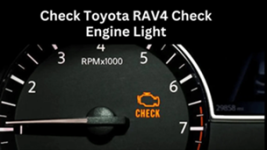The P00BD code is related to the Mass Air Flow (MAF) sensor, specifically indicating that the MAF sensor signal is out of range or higher than expected. Since you've already replaced the MAF sensor and the EGR valve, here are some additional steps to help diagnose and resolve the issue:
1. Double-Check the New MAF Sensor
Ensure the replacement MAF sensor is of high quality and compatible with your Toyota RAV4. Aftermarket sensors can sometimes cause issues if they don't meet OEM specifications.
Inspect the wiring and connectors to the MAF sensor for damage, corrosion, or loose connections. Even a slight issue here can trigger the code.

2. Inspect for Air Leaks
A leak in the intake system can cause incorrect air readings and trigger the P00BD code:
Check for vacuum leaks in the intake manifold, hoses, and air intake duct.
Ensure the air filter is properly installed and not obstructed.
Inspect the air intake duct for cracks or gaps between the air filter housing and the throttle body.
3. Check the EGR System Again
The EGR replacement may not have resolved all issues. Ensure:
The EGR valve is correctly installed and functioning.
The EGR passages are free of carbon buildup, which can obstruct airflow and trigger the code.
4. Clean the Throttle Body
A dirty throttle body can also cause airflow issues and confuse the MAF sensor. Clean the throttle body with a suitable cleaner and ensure the butterfly valve moves freely.
5. Investigate the Fuel System
Fuel delivery issues (e.g., faulty fuel injectors or low fuel pressure) can cause incorrect air-fuel ratios, triggering the code. Consider:
Checking the fuel injectors for proper operation.
Verifying fuel pressure with a fuel pressure gauge.
6. Update or Reset the ECU
After replacing components, it's important to reset the ECU to clear learned data. If not done, the ECU may still use old MAF sensor calibration values.
Use an OBD-II scanner to clear the code and reset the ECU.
Drive the vehicle and monitor for the code to reappear.
If available, check for any ECU software updates from Toyota, as a reflash may resolve certain sensor calibration issues.
7. Test the Vehicle with a Diagnostic Scanner
Use a live-data-capable OBD-II scanner to monitor MAF sensor readings and compare them with manufacturer specifications. Look for:
Sudden spikes or drops in airflow readings.
Consistency of data at idle and under load.
8. Check for Other Underlying Issues
Other sensors like the intake air temperature (IAT) sensor or oxygen sensors may contribute to airflow and air-fuel mixture discrepancies. Ensure these are functioning correctly.
When to Seek Professional Help
If you've tried all the above steps and the code persists, consider having a professional mechanic perform a detailed diagnostic. They may conduct:
A smoke test to find hidden air leaks.
Advanced diagnostics to test ECU functionality or wiring issues in the MAF circuit.
1. Double-Check the New MAF Sensor
Ensure the replacement MAF sensor is of high quality and compatible with your Toyota RAV4. Aftermarket sensors can sometimes cause issues if they don't meet OEM specifications.
Inspect the wiring and connectors to the MAF sensor for damage, corrosion, or loose connections. Even a slight issue here can trigger the code.

2. Inspect for Air Leaks
A leak in the intake system can cause incorrect air readings and trigger the P00BD code:
Check for vacuum leaks in the intake manifold, hoses, and air intake duct.
Ensure the air filter is properly installed and not obstructed.
Inspect the air intake duct for cracks or gaps between the air filter housing and the throttle body.
3. Check the EGR System Again
The EGR replacement may not have resolved all issues. Ensure:
The EGR valve is correctly installed and functioning.
The EGR passages are free of carbon buildup, which can obstruct airflow and trigger the code.
4. Clean the Throttle Body
A dirty throttle body can also cause airflow issues and confuse the MAF sensor. Clean the throttle body with a suitable cleaner and ensure the butterfly valve moves freely.
5. Investigate the Fuel System
Fuel delivery issues (e.g., faulty fuel injectors or low fuel pressure) can cause incorrect air-fuel ratios, triggering the code. Consider:
Checking the fuel injectors for proper operation.
Verifying fuel pressure with a fuel pressure gauge.
6. Update or Reset the ECU
After replacing components, it's important to reset the ECU to clear learned data. If not done, the ECU may still use old MAF sensor calibration values.
Use an OBD-II scanner to clear the code and reset the ECU.
Drive the vehicle and monitor for the code to reappear.
If available, check for any ECU software updates from Toyota, as a reflash may resolve certain sensor calibration issues.
7. Test the Vehicle with a Diagnostic Scanner
Use a live-data-capable OBD-II scanner to monitor MAF sensor readings and compare them with manufacturer specifications. Look for:
Sudden spikes or drops in airflow readings.
Consistency of data at idle and under load.
8. Check for Other Underlying Issues
Other sensors like the intake air temperature (IAT) sensor or oxygen sensors may contribute to airflow and air-fuel mixture discrepancies. Ensure these are functioning correctly.
When to Seek Professional Help
If you've tried all the above steps and the code persists, consider having a professional mechanic perform a detailed diagnostic. They may conduct:
A smoke test to find hidden air leaks.
Advanced diagnostics to test ECU functionality or wiring issues in the MAF circuit.
